Part 1 of 5: COVID-19 Impact on College Student Mental Health
The impact of COVID-19 has led to widespread concerns about its unique effects on college students' mental health. Surveys of college students conducted after March 2020 have repeatedly suggested that psychological distress among college students has increased. CCMH data, representing nearly 50,000 treatment-seeking students at 140+ institutions, suggests that the impact of COVID-19 on college students' mental health is considerably more nuanced than generally reported. To examine the impact of COVID-19 on mental health more thoroughly, using a broader range of longitudinal clinical data, CCMH will offer a five-part blog series to describe the impact of COVID-19 on college student mental health from multiple perspectives. While surveys offer an important perspective and provide an immediate snapshot of data, CCMH data is gathered methodically over time and then examined retrospectively. While this method requires patience for data to accumulate, it also provides a more robust population-level perspective (among students seeking services).
Update: Numbers in this blog were corrected on October 4, 2021 to exclude clients who did not complete the COVID impact form, which increased rate of endorsement for each COVID impact area by <10%.
In our September 2020 Blog, CCMH examined distress changes from before and immediately after the onset of COVID-19 by comparing data from the 2018-2019 and 2019-2020 academic years (through June 2020). Data indicated only a few minor changes in student-reported distress (academic and family) between pre- and post-COVID-19 periods. While preliminary in nature, these results suggested that the relationship between COVID and college student mental health might be more nuanced than was being reported.
For this first blog, CCMH analyzed data from 43,098 college students seeking treatment at 137 counseling centers during the Fall 2020 (7/1/2020 to 11/30/2020). Clinical information was gathered from students and clinicians via the Standardized Data Set (SDS), the Counseling Center Assessment of Psychological Symptoms (CCAPS), and the Clinician Index of Client Concerns (CLICC) at student’s initial appointment. This blog will examine the following questions:
- What proportion of students sought mental health treatment due to COVID-19?
- Which aspects of students' lives were negatively impacted by COVID-19?
- Do students who sought mental health treatment because of COVID-19 differ from those who did not?
- Do students who report that COVID-19 negatively impacted their “mental health” differ from those who do not?
What proportion of students sought mental health treatment due to COVID-19?
At the beginning of treatment, students were asked if their reasons for seeking services were related to the COVID-19 pandemic. Of the 43,098 clients who provided data, 33% indicated that their reasons for seeking services were related to the COVID-19 pandemic or related events, while 67% did not.
Which aspects of students' lives were negatively impacted by COVID-19?
All 43,098 students seeking services (not just those seeking services because of COVID -19) were also asked to report which areas of their life had been negatively impacted by COVID-19; students were asked to “check all that apply”. The most common areas affected were mental health (72%), motivation or focus (68%), loneliness or isolation (67%), academics (66%), and missed experiences or opportunities (60%).
| Area of Impact | Percent |
| Mental health | 72% |
| Motivation or focus | 68% |
| Loneliness or isolation | 67% |
| Academics | 66% |
| Missed experiences or opportunities | 60% |
| Career/employment | 44% |
| Relationships (significant other, family, friends) | 43% |
| Financial | 35% |
| Health concerns (other) | 30% |
| Health concerns (self) | 26% |
| Grief/loss of someone | 9% |
| Food or housing insecurity | 9% |
| Discrimination/harassment | 3% |
| Other (please specify) | 1% |
Overall, 94% of students reported at least one area was negatively impacted, with 90% reporting multiple areas being affected.
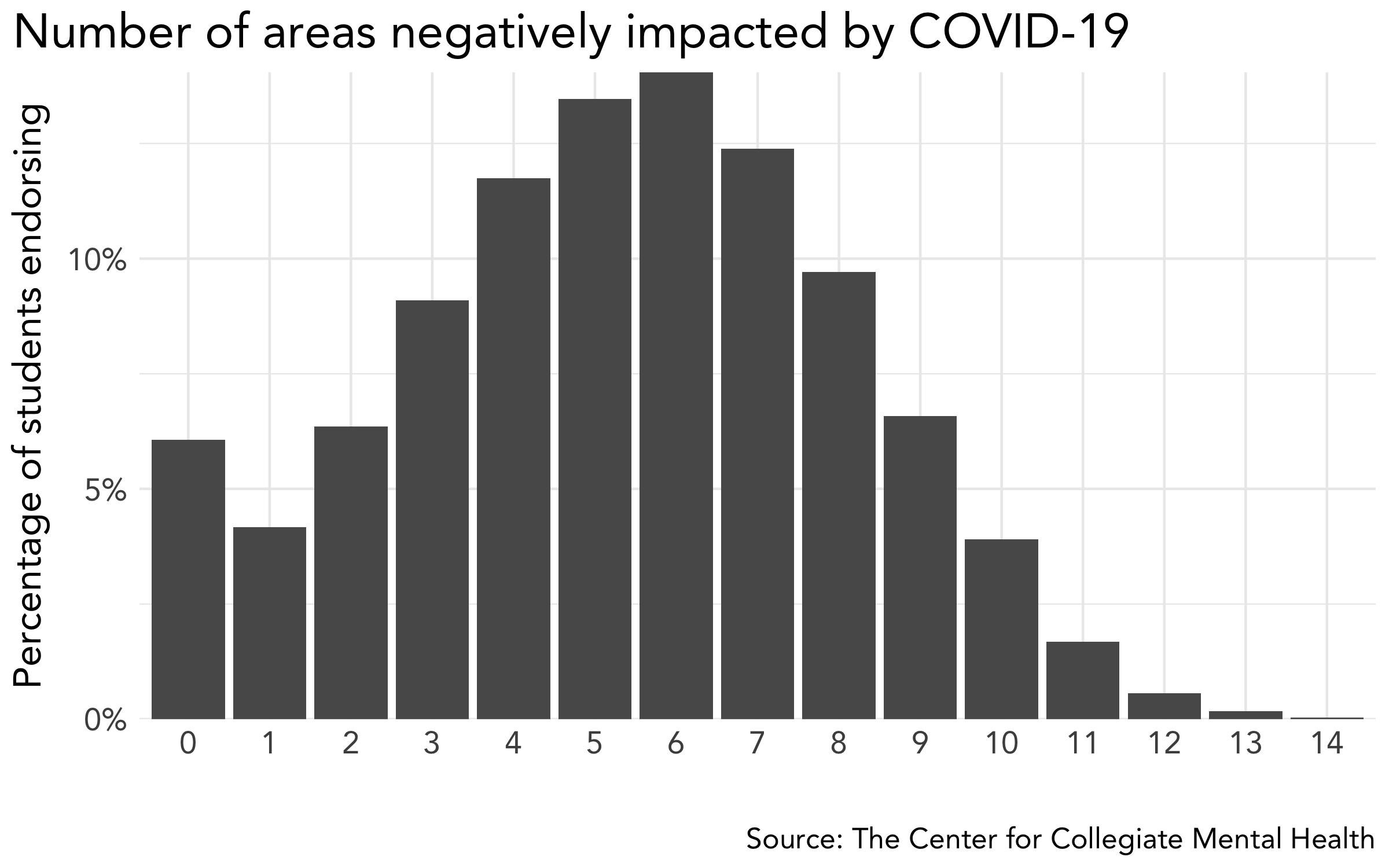
Do students who sought mental health treatment because of COVID-19 differ from those who did not?
Students who sought treatment because of COVID-19 reported higher rates of negative life impacts across all areas when compared to students who initiated treatment for other reasons.
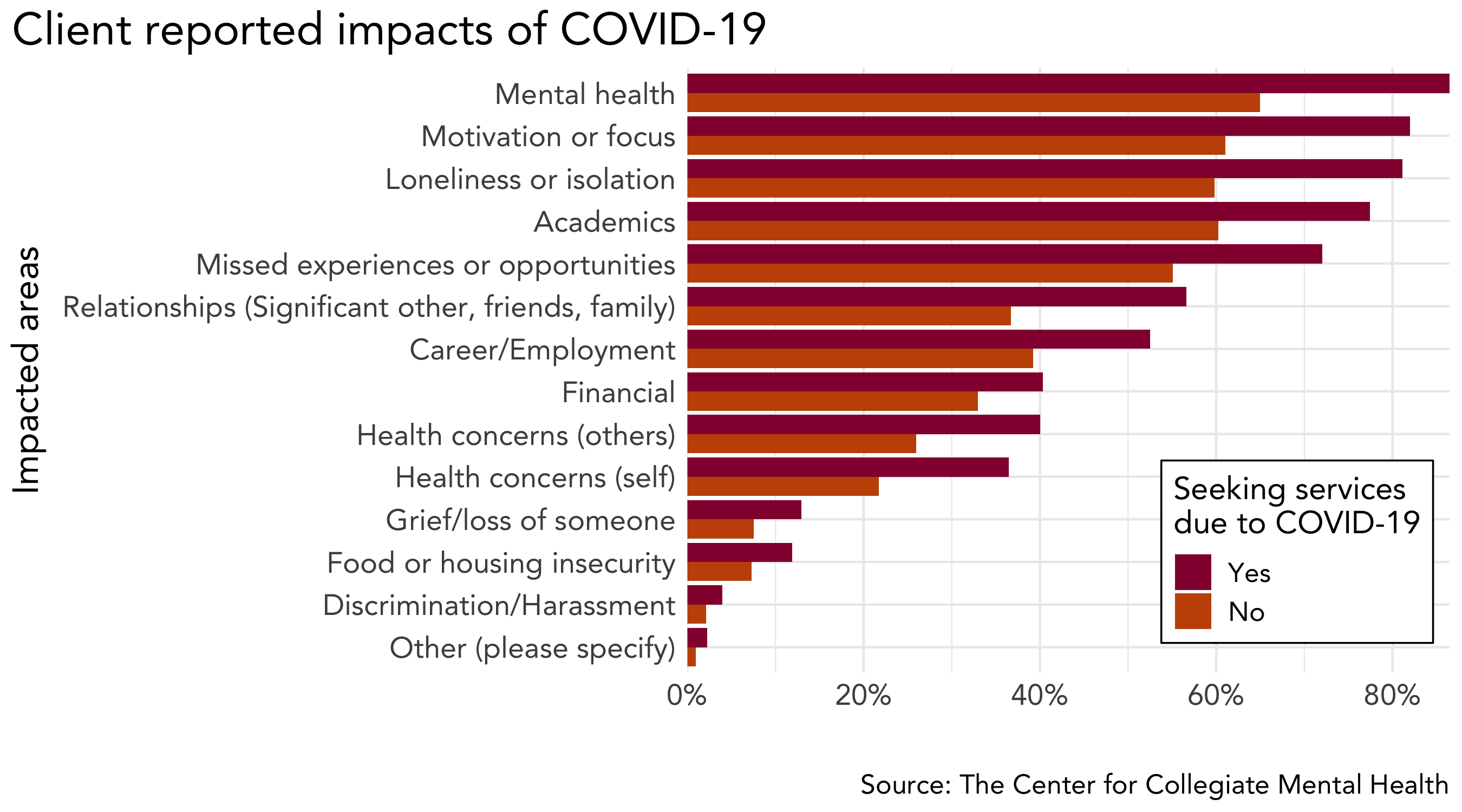
In addition to the questions above, counseling centers that are part of CCMH ask students to complete the CCAPS to measure levels of mental health distress, which provides the opportunity to examine if self-reported distress (as measured by the CCAPS) varies according to whether students sought treatment because of COVID-19 or for other reasons. The table below illustrates average CCAPS scores among these two groups and the national average (black-line). Students who sought services due to the COVID-19 pandemic reported slightly more depression, generalized anxiety, and general distress symptoms, as well as significantly more academic distress. However, levels of social anxiety, eating concerns, hostility and alcohol use symptoms were broadly similar to those seeking care for other reasons.
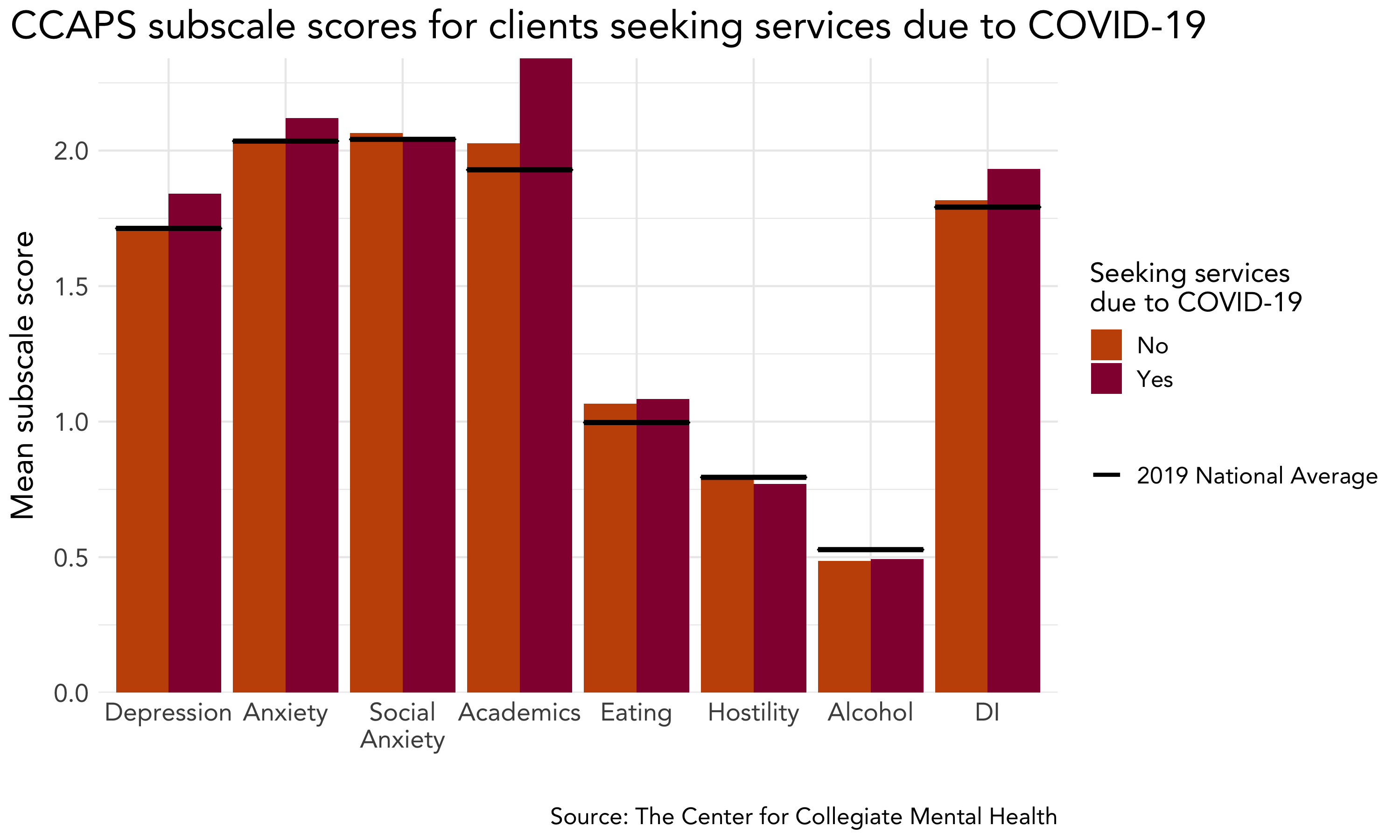
Counseling center members of CCMH also ask clinicians to provide standardized data on students they evaluate using the CLICC. The table below illustrates that clinicians were more likely to assess anxiety, stress, generalized anxiety, depression, academic performance, social isolation, and adjustment to a new environment as presenting concerns in students who sought services due to COVID-19. However, family, relationship problems, and interpersonal functioning were more likely to be identified as presenting concerns in students seeking services for other reasons.
CLICC check all by "seeking services" item
| Check all concern | No | Yes | No ranking | Yes ranking |
| Anxiety | 66% | 68% | 1 | 1 |
| Stress | 45% | 56% | 4 | 2 |
| Generalized anxiety | 48% | 52% | 2 | 3 |
| Depression | 47% | 50% | 3 | 4 |
| Academic performance | 24% | 32% | 6 | 5 |
| Family | 30% | 30% | 5 | 6 |
| Social isolation | 13% | 23% | 15 | 7 |
| Adjustment to new environment | 14% | 21% | 14 | 8 |
| Relationship problem (specific) | 22% | 19% | 7 | 9 |
| Interpersonal functioning | 19% | 18% | 8 | 10 |
Do students who report that COVID-19 negatively impacted their “mental health” differ from those who do not?
Again using CCAPS scores for comparison, students who indicated that their “mental health” was negatively impacted by COVID-19 consistently reported higher levels of mental-health distress in all areas including depression, generalized anxiety, social anxiety, academic distress, eating concerns, hostility, alcohol use, and general distress symptoms. In addition, students reporting their “mental health” was negatively impacted were also consistently higher than the national averages.
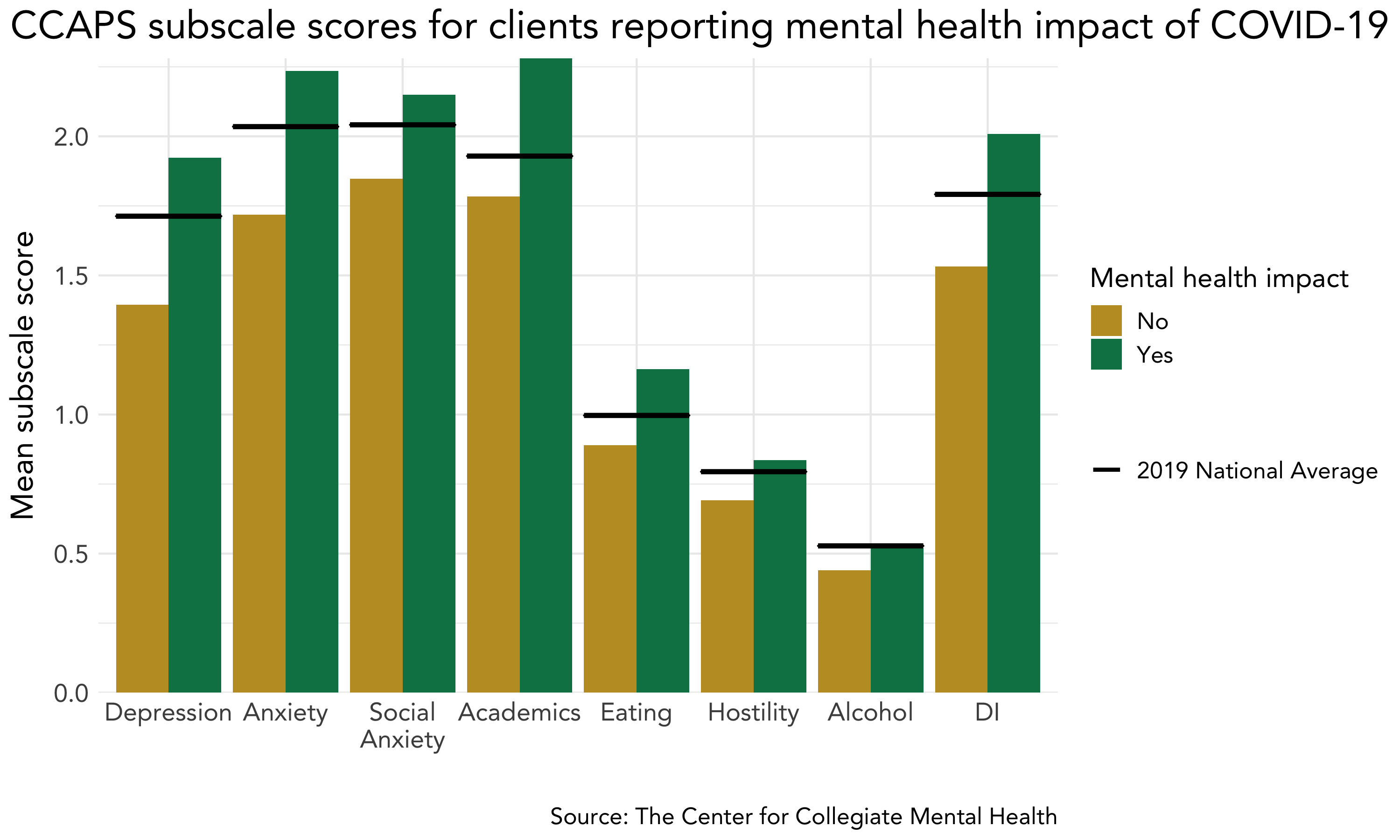
Using the CLICC data for comparison, the table below shows that clinicians assessed anxiety, stress, generalized anxiety, depression, academic performance, social isolation, family, and adjustment to a new environment as presenting concerns at higher rates for students seeking mental health services due to COVID-19. However, relationship problems and interpersonal functioning were more likely to be identified as presenting concerns in students who indicated that their mental health was not impacted from COVID-19.
CLICC check all by "mental health impact"
| Check all concern | No | Yes | No rank | Yes rank |
| Anxiety | 58% | 71% | 1 | 1 |
| Generalized anxiety | 41% | 54% | 3 | 2 |
| Depression | 37% | 53% | 4 | 3 |
| Stress | 48% | 49% | 2 | 4 |
| Family | 30% | 31% | 5 | 5 |
| Academic performance | 24% | 28% | 7 | 6 |
| Social anxiety | 17% | 19% | 11 | 7 |
| Interpersonal functioning | 20% | 19% | 8 | 8 |
| Relationship problem (specific) | 25% | 19% | 6 | 9 |
| Trauma | 17% | 19% | 10 | 10 |
To explore whether there is an interaction between seeking treatment because of COVID-19 (Yes or No COVID) and reporting that one’s mental health was negatively impacted by COVID-19 (Yes or No MH), the following chart illustrates average levels of mental health distress, measured by the CCAPS, for each combination.
Students who reported that their mental health was negatively impacted by COVID-19 also reported higher levels mental health distress in seven areas (depression, generalized anxiety, social anxiety, eating concerns, hostility, alcohol use, and general distress), regardless of whether they sought services because of COVID-19. Again, these levels were also higher than national average.
However, for academic distress, both factors (seeking services due to COVID-19 & reporting negative mental health impacts) appeared to contribute to elevated distress.
By intersection of “seeking services” and “mental health impact”
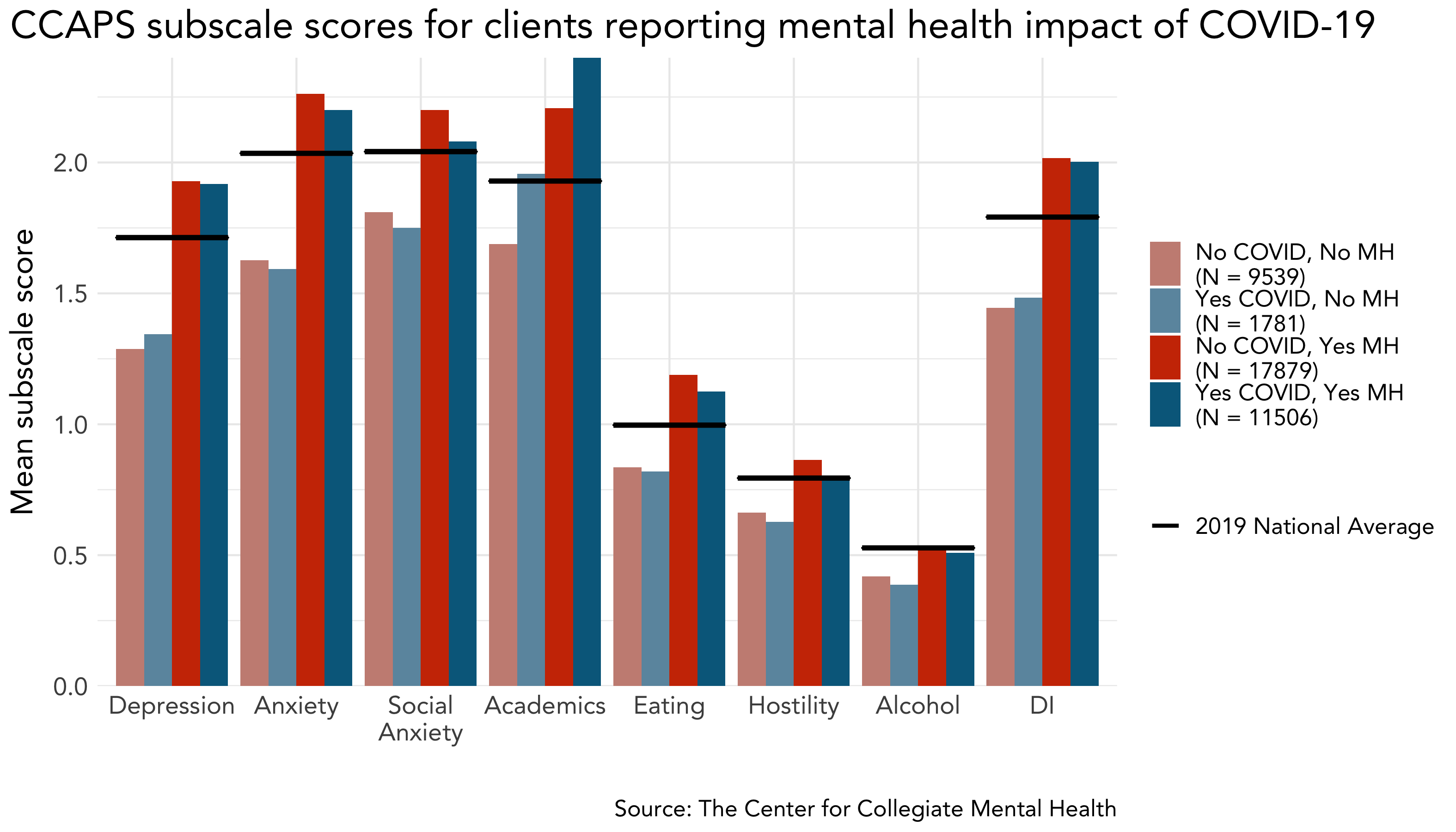
Summary and Suggestions
Since the onset of COVID-19, there have been consistent and important questions about how college student mental health has been impacted and what should be done. Over the last 11 months, data have generally been limited to snapshot surveys, which can be influenced by dominant narratives and the expression of distress through imprecisely defined words and phrases. In general, these data points have consistently indicated that college student “mental health is worse” as a function of COVID-19, but the details of this relationship have been unclear, as has the path forward. In this blog, Part 1 of 5, CCMH began a deeper dive into this complex relationship by examining 43,098 college students seeking treatment at 137 counseling centers during the Fall 2020 (7/1/2020 to 11/30/2020) to. The following findings and takeaways are noted:
- One third of students sought mental health services due to the COVID-19 pandemic, whereas 2/3 did not. In other words, the majority of students seeking mental health care did so for reasons other than COVID-19.
- Regardless of the reason for seeking mental health care, the vast majority of students seeking mental health care reported that COVID-19 has negatively impacted at least one aspect of life (94%), with mental health (72%), motivation or focus (68%), loneliness or isolation (67%), academics (66%), and missed experiences and opportunities (60%) as the most frequently areas affected. These will be critical aspects of the student experience for colleges and universities to focus on in the coming months. It is worth noting that 28% of students seeking mental-health services report that COVID-19 did not negatively impact their mental health.
- Students who report that their “mental health” was negatively impacted by COVID-19 appear to be using this phrase to represent a broad range of distress. These students reported elevated symptoms across mental health distress types (even beyond typical national averages) AND were assessed by clinicians as being more likely to have depression, anxiety, and a variety of other mental-health concerns. The alignment of these three factors (negative mental health impact, elevated self-reports of distress, and clinician confirmation of presenting problems) suggests that this phrase may be functioning as a general expression of distress. This research dynamic raises important questions about self-report response styles and the pros and cons of using a generic phrase ("mental health") to measure a complex set of constructs.
- By contrast, students who reported seeking mental health services due to COVID-19 reported only slightly increased distress in a few mental-health domains. This suggests that COVID-19 is not universally driving mental-health distress. Rather, it appears that a student’s perception/belief/experience that COVID-19 negatively impacted their “mental health” is the primary driver of subsequently measured mental-health distress (student and clinician).
- Student’s self-reported Academic Distress appears to be uniquely elevated both for students seeking services because of COVID-19 and for whom mental health was negatively impacted. This suggests that overall academic distress is being driven by both factors.
In summary, COVID-19 is negatively impacting many aspects of students' lives, as it is for nearly everyone. Interventions by colleges and universities in the coming year should be targeted on improving students' experience of mental health, supporting their ability to motivate/focus, fostering social connections, alleviating academic distress caused by COVID-19, helping students make up for missed experiences and opportunities, facilitating their transition back to pre-COVID-19 routines, and attending to areas of basic need, including food/housing insecurities. Academic distress appears to be a key driver in seeking mental-health care during COVID-19, which may represent a broader experience of distress caused by academic worry.
While COVID-19 is an important variable to consider when planning interventions, these findings suggest that a student’s perception of negative impacts on “mental health” from COVID-19 (and perhaps more broadly) may be a particularly important area of assessment to identify students who are struggling and have a diverse set of needs. Students who report this general negative mental health affect from the pandemic are suffering at much higher rates in almost all major areas of their lives, including distress levels. Conversely, students who enter services reporting no negative mental health impact from COVID-19 also have significant care needs that are more likely to linked to relationship and interpersonal concerns. Overall, it will be essential for colleges and universities to be attentive, prepared, resourced, and creative to address the ongoing and future challenges encountered by students due to the pandemic, especially as they re-integrate to pre-COVID-19 student life.
Please stay tuned for Part 2 of the CCMH COVID-19 Blog series, which covers updated data on the changes in student distress and presenting concerns by comparing data from the 2018-2019 and 2019-2020 academic years. Part 3 of the CCMH COVID-19 Blog series explores the impact of COVID-19 on the mental health of various identity groups.

